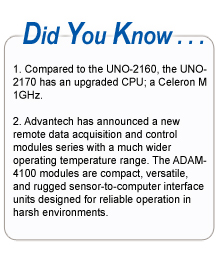
|
|||
| >
ADAMLink
Home |
|||
|
Most industrial automation system users have heard of new generation controllers like Hybrid & PAC since early 2000, but how many of them know why a new control system was required? We already have the PLC (Programmable Logic Controller) and DCS (Distributed Control System), and certainly they are both powerful enough to meet existing requirements. Although each type of controller works well and is upgraded with additional hardware & software continuously, we needed more enhanced features. The most efficient method was to modify the existing model, as there was not a critical reason to design a totally new control system yet. It has been said that because the PAC is a PC-based control system, it is the current technical trend for the foreseeable future, but another powerful PC-based control system, the DCS, already existed, and is popular in the market now¡K.so the compelling question becomes, "Why did we need the PAC?" At first, the Hybrid controller and PAC seem quite similar, the only obvious difference being their names. Almost all of the control engineers know that PLC is used for logic control and general purpose applications, and doesn't need high computing capabilities. On the other hand, the DCS is used for process and complex control applications that require powerful computing capabilities. It looked be perfect; we have different choices to satisfy our needs, regardless of our requirements.The problem though was that although the PLC was cheap, it was without powerful enough computing capabilities for complex control requirements, and while the DCS was very powerful, it was also very expensive. The only clear solution was to try and identify our users' exact requirements. Not all control applications are simple enough to be satisfied by PLC, and most of the control applications are so complex that we needed an expensive system like the DCS. The perfect solution was a combination of the two; a control system slightly more powerful than PLC but cheaper than DCS. Such a requirement combines the best features of both the PLC and DCS, and is a "Hybrid" solution. This is why we have heard of a Hybrid controller before, but "Hybrid" is not a technical term. The new term, "PAC", has replaced "Hybrid" as the name for this type of combination controller. Since the PAC system was initiated from the above concept, we can summarize the below definition: Definition of a PAC:
We now have
a more clear profile of the PAC. The details of the hardware and
software requirements will be discussed in the next section.
|
|
||
|
|
|||
|
Advantech
Industrial Automation ADVANTECH
Automation 1320 Kemper Meadow Dr., Ste 500, Cincinnati, OH 45240.
877-294-8989 |
|||
